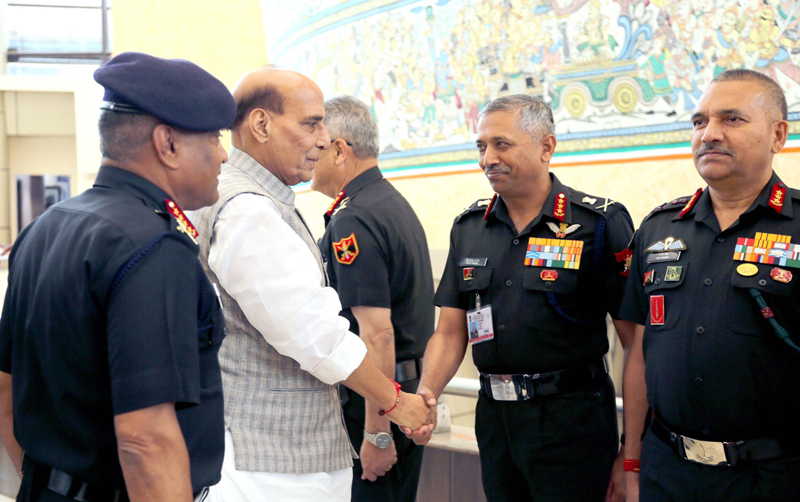
‘Best weapons, equipments for troops’
NEW DELHI, Apr 19:
Defence Minister Rajnath Singh today asked top Army commanders to maintain a strong vigil along the Line of Actual Control with China as the situation in the northern sector remained “tense” due to the deployment of PLA troops.
In his address at the Army Commanders’ Conference, Singh, referring to the eastern Ladakh border row, expressed full confidence in the Army to deal with any contingency while noting that the ongoing talks for peaceful resolution of the issue will continue.
He said disengagement and de-escalation is the “best way forward”, the defence ministry said.
Singh said a “whole of the government” approach is being followed to ensure the availability of best weapons, equipment and clothing to the troops defending the country’s territorial integrity while braving extreme weather and hostile forces, according to the ministry.
The defence minister reaffirmed the faith of the billion-plus citizens in the Indian Army as one of the most trusted and inspiring organisations in the country.
“The situation is tense due to deployment of PLA troops in the northern sector. Our armed forces, especially the Indian Army, will have to continuously keep their vigilance in order to maintain the security of the LAC,” he said, according to sources.
The defence minister said the security of the country is the “topmost priority” for the government.
In a statement, the ministry said Singh complimented Border Roads Organisation, saying its efforts have led to the incomparable improvement of road communication in the border areas.
The five-day Army Commanders’ Conference began on Monday. It is deliberating on India’s national security challenges along the borders with China and Pakistan and ways to boost combat capability of the force.
Chief of Defence Staff Gen Anil Chauhan, Army Chief Gen Manoj Pande, Navy Chief Admiral R Hari Kumar and Air Chief Marshal V R Chaudhari also addressed the commanders.
Talking about the global geopolitical scenario, Singh said, “Unconventional and asymmetric warfare, including hybrid war will be part of the future conventional wars.”
“Cyber, information, communication, trade and finance have all become an inseparable part of future conflicts. This necessitates that Armed Forces will have to keep all these facets in consideration while planning and formulating strategies,” he said.
On the situation along the Western borders, he complimented the Army’s response to cross-border terrorism, adding the proxy war by the adversary continues.
“I compliment the excellent synergy between the Central Armed Police Forces/Police forces and the Army in tackling the menace of terrorism in Jammu and Kashmir,” he said.
“The synergised operations in the Union Territory of Jammu and Kashmir are contributing to increased stability and peace in the region and the same should continue, and for this I again compliment the Indian Army,” Singh said.
The defence minister commended the Army for the high standard of operational preparedness and capabilities which he said he has always been experiencing first hand during his visits to forward areas.
“In the North-Eastern states too, there has been a lot of improvement in the internal security scenario following operations carried out by the Indian Army,” Singh said.
The defence minister said there is a need to ensure the use of real-time intelligence more effectively so that “we can be fully prepared to face any such future challenges.”
The defence minister lauded the Army’s efforts to develop niche technologies in collaboration with civil industries.
He also stressed that as users the armed forces must put their faith in the Indian industries and technologies. The defence minister also complimented the Army for the execution of the ‘Agniveer’ scheme.
He also reviewed an equipment display focusing on niche technology, innovation, solutions for surveillance, artificial intelligence, training, robotics, virtual reality, operational logistics etc.
The defence minister released the second edition of Indian Army UN Journal titled ‘Blue Helmet Odyssey—Changing Contours of Peacekeeping Operations in the 20th Century’. (PTI)

